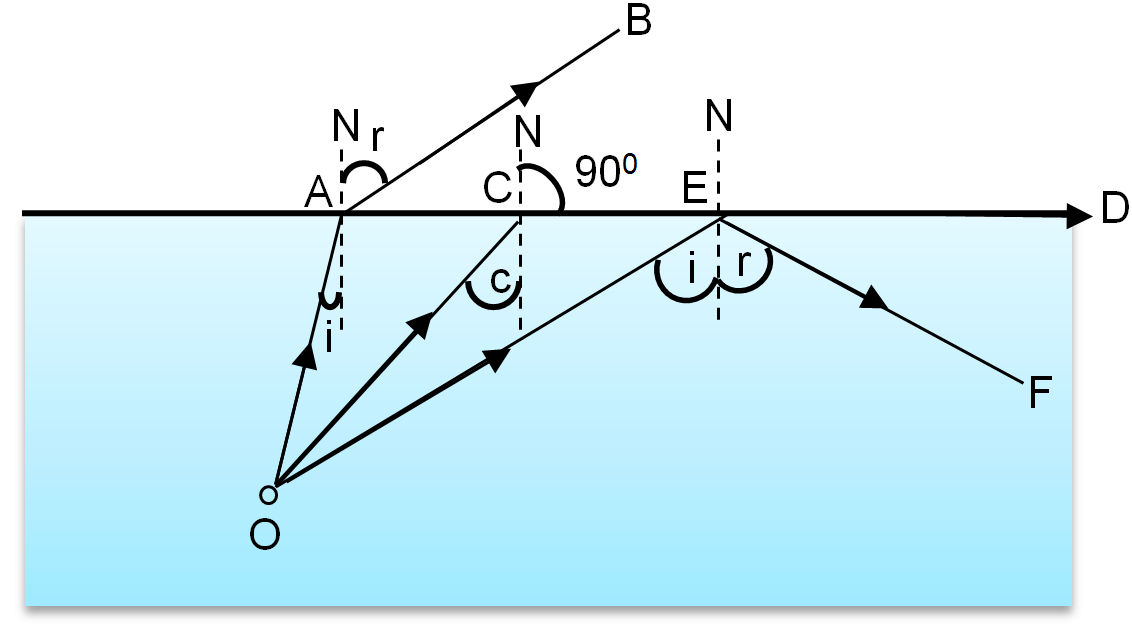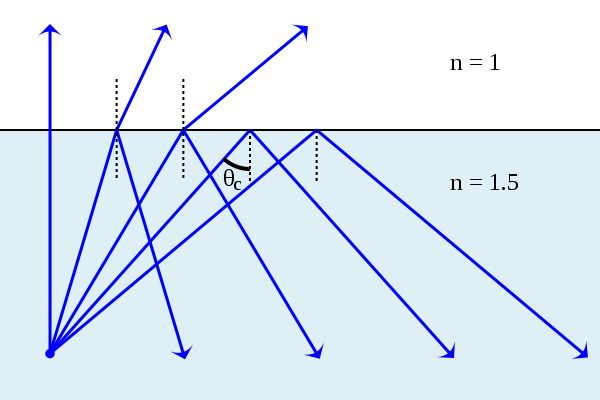

For visible light, the critical angle is about 49° for incidence from water to air, and about 42° for incidence from common glass to air.ĭetails of the mechanism of TIR give rise to more subtle phenomena. As the angle of incidence increases beyond the critical angle, the conditions of refraction can no longer be satisfied, so there is no refracted ray, and the partial reflection becomes total. As the angle of incidence approaches a certain threshold, called the critical angle, the angle of refraction approaches 90°, at which the refracted ray becomes parallel to the boundary surface. When waves are refracted from a medium of lower propagation speed (higher refractive index) to a medium of higher propagation speed (lower refractive index) -e.g., from water to air-the angle of refraction (between the outgoing ray and the surface normal) is greater than the angle of incidence (between the incoming ray and the normal). Refraction is generally accompanied by partial reflection. The color of the laser light itself is deep violet but its wavelength is short enough to cause fluorescence in the glass, which re-radiates greenish light in all directions, rendering the zigzag beam visible. If the waves are capable of forming a narrow beam (Fig. 2), the reflection tends to be described in terms of " rays" rather than waves in a medium whose properties are independent of direction, such as air, water or glass, the "rays" are perpendicular to the associated wavefronts.įig. 2: Repeated total internal reflection of a 405 nm laser beam between the front and back surfaces of a glass pane. TIR occurs not only with electromagnetic waves such as light and microwaves, but also with other types of waves, including sound and water waves. For example, the water-to-air surface in a typical fish tank, when viewed obliquely from below, reflects the underwater scene like a mirror with no loss of brightness (Fig. 1). It occurs when the second medium has a higher wave speed (i.e., lower refractive index) than the first, and the waves are incident at a sufficiently oblique angle on the interface. In physics, total internal reflection ( TIR) is the phenomenon in which waves arriving at the interface (boundary) from one medium to another (e.g., from water to air) are not refracted into the second ("external") medium, but completely reflected back into the first ("internal") medium. And the setup at the right hand side is showing the total internal reflection setup, where angle i is greater than critical angle c causing the light’s total internal reflection.Fig. 1: Underwater plants in a fish tank, and their inverted images (top) formed by total internal reflection in the water-air surface. angle of incidence equals critical angle. The left one is for critical angle set up where i=c, i.e. In the above diagram, two setups are shown. total internal reflection (the set in the RHS) This phenomenon is called total internal reflection. Definition of total internal reflection: When the angle of incidence in the denser medium is greater than the critical angle the light reflected back into the same medium. This is known as total internal reflection. If the angle of incidence is further increased, the rays do not undergo refraction, it gets reflected into the same optically denser medium.

This angle of incidence in the denser medium is called ‘critical angle’, In the diagram above, the angle of incidence i3 is the critical angle that makes the angle of refraction r3=90 degrees. Definition of critical angle: At a particular angle of incidence in the denser medium, the refracted ray just grazes the refracting surface making the angle of refraction is equal to 90°. Gradually if the angle of incidence increases, the angle of refraction also increases. Hence, the angle of refraction is greater than the angle of incidence. When a ray of light passes from denser to rarer medium, the refracted ray bends away from the normal. What are the total internal reflection and critical angle?

This post is on the total internal reflection and critical angle. Last updated on April 14th, 2021 at 05:23 pm


 0 kommentar(er)
0 kommentar(er)
